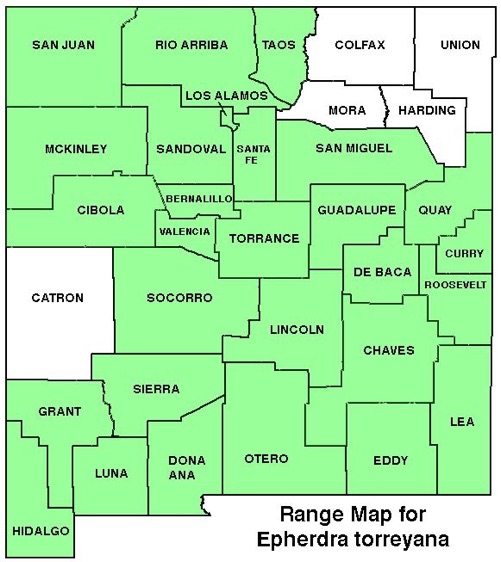WILDFLOWERS OF NEW MEXICO

Woody shrubs form branching clumps 2–5 feet tall and wide with rigid, pencil-thin, stems. Photosynthesis occurs in the young blue-green to olive stems, not in the leaves. The tiny, brown, scale-like leaves whorl in sets of three around the stem nodes, becoming shredded with age. With papery cones instead of flowers, ephedras evolved 125 million years ago along with cone-bearing conifers. The creamy-yellow male and brownish female cones grow on separate plants. *Note the cones are sessile (not growing on tiny stalks), and the stem tips are pointed but not spine-tipped.
Occurring worldwide, Ephedras are gymnosperms (seeds borne in cones, not in a fruit) that thrived during the Cretaceous period when dinosaurs roamed the earth and angiosperms (seeds borne in a ovary–fruit) first appeared in fossil records. The common ancestor to current joint-fir species dates back 30–65 million years.
CONES (Flower): April–August. Cones grow in sets of one to several at nodes along the stem. Female (seed) cones are sessile (stemless) with whorls of papery, oval, tan-yellow bracts 1/4–3/8 inch long (6–9 mm). Male (pollen) cones are also sessile with oval, yellow bracts; tiny pollen-bearing stalks protruding beyond the cone have 5–8 lobes (use lens). The cones are wind pollinated, though some species can sense lunar phases and attract bees and moths during the full moon.
LEAVES: Whorled in sets of 3 at nodes. Blades scale-like, 1/16–3/16 inch long (2–5 mm), with pointed tips; become shredded with age.
HABITAT: Dry sandy, rocky soils of desert hills, badlands, mesas, creosote bush, sand sage, and mesquite brushlands, roadsides, disturbed areas; desert grasslands and scrub, pinyon-juniper woodlands.
ELEVATION: 3,600–6,300 feet.
RANGE: AZ, CO, NM, NV, TX, UT; Mexico.
SIMILAR SPECIES: Another joint-fir common in NM, Ephedra trifurca, in much the same range, has distinctive spine-tipped branches, cones on tiny stalks, and tiny pollen stalks with only 4–5 lobes (use lens). In NM, 2 other species are common but with limited ranges, and 2 species and an hybrid are rare.
NM COUNTIES: Nearly statewide in low- to mid-elevation, dry habitats: Bernalillo, Chaves, Cibola, Curry, De Baca, Dona Ana, Eddy, Grant, Guadalupe, Hidalgo, Lea, Lincoln, Los Alamos, Luna, McKinley, Otero, Quay, Rio Arriba, Roosevelt, San Juan, San Miguel, Sandoval, Santa Fe, Sierra, Socorro, Taos, Torrance, Valencia.
NOTES: Ephedras, which contain caffeine, ephedrine, pseudoephedrine, and other powerful stimulates, have been used medicinally for thousands of years. The Mormons who first settled the West were prohibited from drinking tea or coffee because they contained caffeine, so they got their morning boost from tea made with ephedra stems, which grow abundantly in the western deserts.
JOINT-FIR, MORMAN TEA
EPHERDRA TORREYANA
Joint-fir Family, Ephedraceae
Perennial shrub


















THE CONTENTS OF THIS WEBSITE ARE COPYRIGHTED AND CANNOT BE USED
WITHOUT PERMISSION OF GEORGE OXFORD MILLER
















EMAIL ME































































Young stems are green and photosynthesize; old stems turn gray with age.
Female cones have rows of loose, papery, tan bracts and produce 1–2 seeds.
Male cones have tiny pollen stalks, each with 5–8 lobes (arrow).


Female plants have brown seed cones.
Male plants have yellow pollen cones.









SIMILAR SPECIES
Widespread in southern and north-central NM, Ephedra trifurca has distinctive spine-tipped stems (arrows).












Plants can reach 2–5 feet tall and wide with a tangle of slender stems.







